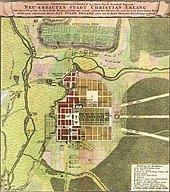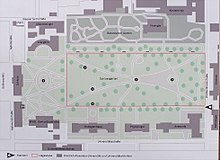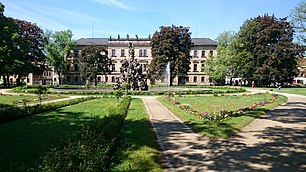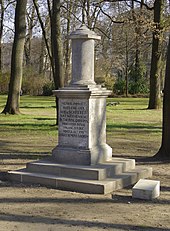Castle garden (Erlangen)
The palace gardens in Erlangen are considered to be one of the first baroque gardens in Franconia . In the garden, which has been accessible to the general public since 1849, the largest garden festival in Europe takes place every year with the Palace Garden Festival of the Friedrich Alexander University .
history
Initially, only a small garden was planned behind the Erlangen Castle, which was built in 1700 . Presumably under the influence of Margravine Elisabeth Sophie , a baroque garden was created, a total of 280 m wide and 550 m long.
The complex was laid out symmetrically to the central axis, which was emphasized by the Huguenot fountain, the equestrian statue and the no longer existing hedge theater . The gardens with the ornamental beds, groups of trees and lawns that were typical of the period were connected to a large square framed by the castle, orangery and the Konkordienkirche. In addition to the pleasure garden with its numerous sculptures and fountains, there was a kitchen garden , a medicinal herb garden , an orchard, a natural garden and a pheasantry . Outside the castle garden walls, the garden continued with three avenues cut into the forest as visual axes.
In the years 1786–1826, at the suggestion of the botany professor Johann Christian von Schreber, it was converted into an English landscape garden. A memorial column was erected in the palace garden in his honor. In 1818 the palace gardens came into the possession of the Friedrich Alexander University, which opened it to the general public on June 11, 1849.
In the 19th century, the palace gardens were reduced considerably to around 7.5 hectares. After the hospital was built in 1803, the eastern part was separated by Krankenhausstrasse. From 1825 the botanical garden was built in the northern edge strip . In the second half of the 19th century, several university institutes and Universitätsstraße were built on the southern edge of the road. Citizens' protests prevented the demolition of the orangery and further development.
In 1946 the municipal garden department took over the maintenance of the palace gardens. The tree population was significantly rejuvenated in 1975 and 1980 by replanting oaks and linden trees.
Orangery
The orangery was planned and built by Gottfried von Gedeler from 1704 to 1706 and was used as a bitter orange house until 1755 . The baroque outer facade shows influences of the early Rococo as well as sandstone sculptures by Elias Räntz . In the middle part there is a water room with significant stucco furnishings and water features fed from the nearby water tower . In 1818 the building became the property of the Friedrich-Alexander-Universität and has since been the seat of the institutes for church music and art history. In addition, the building is used as a splendid location for concerts and weddings, for which several grand pianos and two organs are available.
organ
The organ in the music hall of the Orangery was built in 1987 by Orgelbau Vier (Friesenheim). The purely mechanical instrument has 29 sounding registers , 3 of which are preliminary prints. It has no independent pedal mechanism. The pedal is formed from the Hauptwerk, the registers of which are on alternating loops. The breastwork (IV. Manual) can be swelled via a sliding sill.
|
|
|
|
|||||||||||||||||||||||||||||||||||||||||||||||||||||||||||||||||||||||||||||||||||||||||||||||||||||||||||||||||||||||||||||||||||||||||||||||||||||||||||||||||||||||||||||||||||||||||||||||||||||||||||||||||
- Coupling : I / II, III / II, IV / II, I / P, II / P, III / P, IV 4 ′ / P
Konkordienkirche
In order to create the mirror symmetry to the central axis of the palace garden, the Concordia Church was to be built opposite the orangery. In 1708, however, only the rectangular middle section was executed under the direction of Gottfried von Gedeler. The two curved side sections, which were supposed to contain orangery rooms, were not built. The inauguration took place in 1711. Nevertheless, the church was not regularly used for church services until 1724 and was profaned as early as 1743. Parts of the altar were used for the pulpit altar of the Neustadt church. 1804–24 the building was converted into a rectangular classical building on both sides and from 1840 it was used as a college building for the Friedrich Alexander University . In 1895/96 the building was redesigned again with a neo-baroque facade and a mansard roof . Since then it has served as the seat of the geological-mineralogical institute.
Huguenot fountain
The Huguenot fountain, created in 1706 by the Bayreuth court sculptor Elias Räntz , depicts a conical rock mountain in an oval fountain basin (29 × 19.5 m), which is divided into three levels. On the lowest level, distinguished Huguenot families are depicted, above ancient deities and at the top Margrave Christian Ernst. The cartouches pointing in the four cardinal directions contained texts with praises of the margrave that had since disappeared. An opening in the rock cone allows a view of the equestrian statue of the margrave.
The well was fed by the nearby water tower , which in turn was supplied by the pumping station in the Thalermühle on the Regnitz. For the construction of this well sandstone was used, which now shows strong signs of weathering and made a restoration necessary in 1999.
Equestrian statue
The equestrian statue of Margrave Christian Ernst remained unfinished for structural reasons. While the base architecture was designed by the architect Paul Decker , the sculptor Elias Räntz created the equestrian statue in 1711/12 from a single block of sandstone from the quarries of the castle hill .
The memorial commemorates the margrave's participation in the Turkish wars and shows him on horseback in full armor. Below him are a Turk and Invidia , the personification of envy. The famous equestrian statue of the Great Elector Friedrich Wilhelm of Brandenburg by Andreas Schlueter in front of Charlottenburg Palace served as a model .
The heavily weathered sculpture was willfully damaged several times and has been protected by a fence since 1996.
Schreber column
The column is reminiscent of Johann Christian von Schreber (1739–1810), who taught as a professor of botany at Erlangen University from 1770. He was the founder and director of the Botanical Garden, which was moved to its present location in the northern part of the palace garden in 1826; The transformation of the palace garden into an English landscape garden also goes back to his initiative. The memorial column was donated by his widow in 1810 and after the transfer of the botanical garden and a restoration in 1827 it was re-erected at its current location in the palace garden.
Dolphin fountain
On the occasion of the 100th anniversary of the Friedrich-Alexander-University in 1843, the dolphin fountain was built as the end of the baroque central axis. Originally this fountain only consisted of a fountain basin and a simple pipe from which the fountain emerged. It was not until 1914 that the sculptor Heinrich Mantel Junior built the horn-blowing putto riding a dolphin, which heralds a new, happy age with its mount and the flowing, fruitful water. It is a copy of a lost fountain figure, which was created by Elias Ränz for the margravial castle estate Mon Plaisir . The figure was vandalized in 1934 and replaced by a replica in 1981. Another copy can be found at Hofmannstrasse 35.
Rückert fountain
In 1904, the sculptor Johann Baptist Mantel created the Rückert fountain on the site of the Vogelbrünnlein, based on a design by Theodor Fischer . The compact Art Nouveau fountain is dedicated to the poet Friedrich Rückert , who between 1826 and 1841 worked as a professor of oriental languages at the Friedrich Alexander University in Erlangen. During this time he wrote one of his most successful works, The Wisdom of the Brahmin , from which a verse was incorporated into the well as an inscription :
GIVES THE MORE IT RECEIVES
IT AGAIN. THAT'S WHY
THE REAL POET'S
SONGS NEVER FAIL . LIKE THE
GROUND FLOOR NEVER EXHAUSTES IN
LUST AND HAPPINESS. BECAUSE
EVERYTHING THAT HE GIVES FLOWS BACK INTO
HIM.
FRIEDRICH RÜCKERT "
Fallen memorial
The memorial created by the sculptor Eduard Beyrer was opened to the public on July 1, 1930 in honor of the members of the university who died in the First World War . It represented a seated, bound soldier with a steel helmet on a boulder, who holds a broken sword in his hand. The inscription “All powers to defy oneself” testifies to the Treaty of Versailles, which was perceived as a dictate .
In November 1946, the warrior figure was eliminated by order of the American military government. Only the 8 stone blocks with 384 names and the pedestal remained.
From the beginning this monument was instrumentalized by changing political currents. In his speech on the occasion of the revelation in 1930, the National Socialist student Sunkel demanded the removal of the Weimar Republic. The smearings on the occasion of the Gulf War 1991 can also be assigned to this “tradition”.
Events
The palace garden is often used for events. The bigger ones include:
- The Sunday Palace Garden Concerts
- The annual Erlanger Poet Festival
- The palace garden festival of the Friedrich Alexander University
Web links
Individual evidence
Coordinates: 49 ° 35 ′ 53 ″ N , 11 ° 0 ′ 24 ″ E














